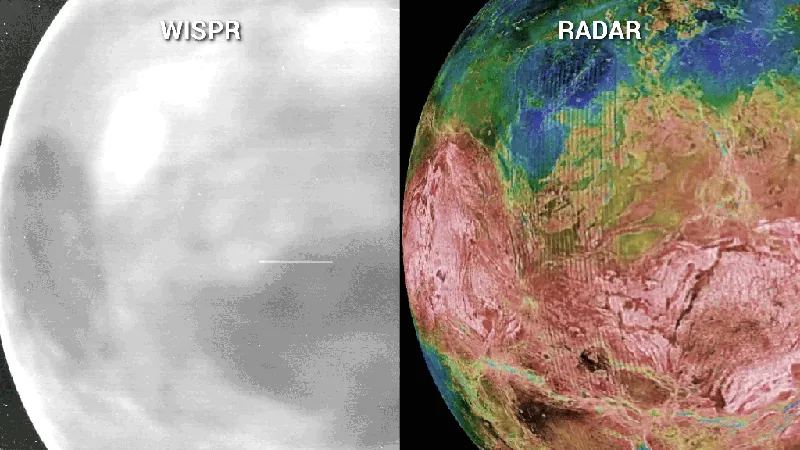
NASA’s Parker Solar Probe Set to Make Historic Final Venus Flyby Before Burning Close to the Sun
2024-11-04
Author: William
Overview
On November 6, 2024, NASA's Parker Solar Probe will execute its final gravity assist maneuver by flying within a mere 233 miles (376 km) of Venus’s surface. This critical passing will refine Parker's trajectory into its ultimate orbit, positioning the spacecraft to approach a staggering 3.86 million miles from the Sun on December 24, 2024—marking a record-setting moment as the closest any human-made object has ever ventured towards our solar system's powerhouse.
Scientific Achievements
The Parker Solar Probe has not only been a groundbreaking mission in solar research but has also inadvertently become an innovative tool for Venusian studies. During its third flyby of Venus on July 11, 2020, scientists repurposed Parker's Wide-Field Imager for Parker Solar Probe (WISPR) to capture visuals of the planet entirely shrouded in its thick atmosphere. To the scientists' astonishment, the instrument was able to penetrate the clouds, revealing insights into the surface of Venus itself.
Innovative Instruments
Noam Izenberg, a space scientist at the Johns Hopkins Applied Physics Laboratory, explained, 'The WISPR cameras can see through the clouds to the surface of Venus, which glows in the near-infrared because it’s so hot.' This newfound capability stirred intense interest, leading to further investigations during subsequent flybys in 2021.
New Discoveries
The imagery collected has not only aligned with data from the historic Magellan spacecraft—which mapped Venus's surface using radar between 1990 and 1994—but has also raised intriguing questions about the planet's geological makeup. Some areas in the WISPR images appeared unexpectedly bright, prompting debates on whether these differences indicate diverse chemical compounds or variations in geological age due to recent volcanic activity.
The Upcoming Flyby
With the upcoming November flyby, scientists are eager to utilize WISPR's visions to further unravel the mysteries of the Venusian landscape. As Izenberg reiterated, 'This flyby provides us with fresh contexts to evaluate whether WISPR can unravel different physical or chemical properties of Venus’s surface.'
Mission Ambitions
After this significant flyby, Parker Solar Probe will zero in on its ambitious goal: a perihelion approach of only 3.8 million miles from the Sun, a milestone that has been decades in the making since the mission was conceived over 65 years ago. This unprecedented close encounter promises to deliver invaluable data about the Sun’s outer atmosphere, navigating through plasma streams directly linked to solar activity—akin to a surfer expertly riding under crashing ocean waves.
Communication and Operations
On December 24, 2024, during the closest approach, communication will temporarily halt, but Parker is expected to send back a beacon tone three days later, on December 27, indicating its success and operational health. The spacecraft will continue to orbit in this proximity as its mission unfolds, completing two additional perihelion passes.
Conclusion
As a key element of NASA's Living with a Star program, Parker Solar Probe is dedicated to unlocking mysteries of the Sun-Earth system that directly impact our existence and technology. Managed by the Goddard Space Flight Center in Maryland, with operations led by the Johns Hopkins Applied Physics Laboratory, this mission marks a thrilling chapter in our relentless pursuit of understanding the celestial mechanics that govern our solar neighborhood.
Looking Ahead
Keep your eyes on the skies, as the future of solar exploration enters uncharted territories!









 Brasil (PT)
Brasil (PT)
 Canada (EN)
Canada (EN)
 Chile (ES)
Chile (ES)
 España (ES)
España (ES)
 France (FR)
France (FR)
 Hong Kong (EN)
Hong Kong (EN)
 Italia (IT)
Italia (IT)
 日本 (JA)
日本 (JA)
 Magyarország (HU)
Magyarország (HU)
 Norge (NO)
Norge (NO)
 Polska (PL)
Polska (PL)
 Schweiz (DE)
Schweiz (DE)
 Singapore (EN)
Singapore (EN)
 Sverige (SV)
Sverige (SV)
 Suomi (FI)
Suomi (FI)
 Türkiye (TR)
Türkiye (TR)